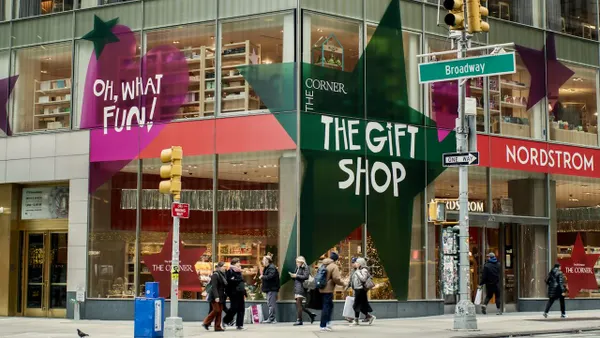Dive Brief:
- Retail sales for November and December are projected to grow 4% year over year and surpass $975 billion, according to a holiday report from Bain & Company.
- In-store sales are expected to grow 2.75% from last year. The strongest gains in store will be seen in apparel and accessories, general merchandise (excluding department stores) and health and personal care, which are projected to grow at least 5%.
- Growth from non-store sales, which include e-commerce and mail orders, is expected to slow, with sales projected to be up 7% year over year. That’s compared to 9% to 10% growth in the category over the past two years. However, non-store sales are still expected to account for half of overall sales growth this season.
Dive Insight:
Bain’s forecast of holiday retail sales falls below the 10-year average of 5.2% as consumers head into the season with more caution.
“This holiday season will be a mixed one for U.S. retailers,” Aaron Cheris, a partner in Bain’s retail practice, said in a statement. “Consumers are cautious and facing financial pressure, but they are also feeling the lift from higher wages and a strong stock market. Leading retailers will strike the right balance — leaning into value, creating warm human experiences while implementing new technologies, and capitalizing on big events like Black Friday to capture share from competitors.”
The Bain report found that 10% more consumers this year will shop on Black Friday and Cyber Monday as value is on most consumers’ minds in 2025. An August report from Klaviyo suggested that cautious consumers would use AI to compare prices as they shopped for items during the Black Friday-Cyber Monday weekend.
Economic uncertainty and financial strain is affecting consumers heading into the holiday season. Some 82% of consumers said they will cut back on essential items such as groceries in order to afford gifts and other products of the season, according to Inmar Intelligence’s 2025 Holiday Commerce Forecast released in July. And credit card delinquencies fo 90 or more days have increased 3% from last year, according to Bain & Company’s report. It’s their highest level since 2011, and most notably coming from consumers under the age of 30.
Gen Z consumers are expected to cut their holiday spending this year by nearly a quarter, in sharp contrast to 2024 when their spending was 37% higher than in 2023, per PwC’s holiday outlook.














